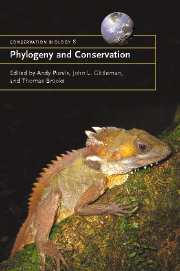Book contents
- Frontmatter
- Contents
- List of contributors
- 1 Phylogeny and conservation
- Part 1 Units and currencies
- Part 2 Inferring evolutionary processes
- 7 Age and area revisited: identifying global patterns and implications for conservation
- 8 Putting process on the map: why ecotones are important for preserving biodiversity
- 9 The oldest rainforests in Africa: stability or resilience for survival and diversity?
- 10 Late Tertiary and Quaternary climate change and centres of endemism in the southern African flora
- 11 Historical biogeography, diversity and conservation of Australia's tropical rainforest herpetofauna
- Part 3 Effects of human processes
- Part 4 Prognosis
- Index
- References
8 - Putting process on the map: why ecotones are important for preserving biodiversity
Published online by Cambridge University Press: 04 December 2009
- Frontmatter
- Contents
- List of contributors
- 1 Phylogeny and conservation
- Part 1 Units and currencies
- Part 2 Inferring evolutionary processes
- 7 Age and area revisited: identifying global patterns and implications for conservation
- 8 Putting process on the map: why ecotones are important for preserving biodiversity
- 9 The oldest rainforests in Africa: stability or resilience for survival and diversity?
- 10 Late Tertiary and Quaternary climate change and centres of endemism in the southern African flora
- 11 Historical biogeography, diversity and conservation of Australia's tropical rainforest herpetofauna
- Part 3 Effects of human processes
- Part 4 Prognosis
- Index
- References
Summary
INTRODUCTION
The mechanisms responsible for generating high rainforest diversity have been of keen interest to biologists for over a century (Moritz et al. 2000; Prance 1982; Wallace 1852). Numerous theories for rainforest diversification and speciation have been advanced, but few have been rigorously tested (Moritz et al. 2000). While the evolutionary processes that give rise to, and maintain, rainforest diversity are debated within the scientific community, the loss and degradation of rainforests continues at an alarming rate. Currently, conservative estimates of rainforest loss in some regions is estimated to approach 1% per year (Achard et al. 2002), and rates of human-induced forest degradation and fragmentation are likely to be many times higher (Wuethrich 2000). Given the current crisis, understanding the processes that generate and maintain rainforest diversity takes on added importance and urgency. Despite the importance of considering evolutionary and ecological process in conservation planning (Desmet et al. 2002; Smith et al. 1993), few rainforest conservation efforts consider landscape features, which harbour the evolutionary processes on which the generation of new biodiversity ultimately depends (Smith et al. 2001a).
The belief that refugial isolation is responsible for rainforest speciation (Haffer 1969, 1997) has, in particular, been an important driver of conservation prioritisation in many regions (Myers et al. 2000; Hamilton et al. 2001; Myers 2002). However, the conservation focus on refugia has serious shortcomings (Smith et al. 2001a; Spector 2002).
- Type
- Chapter
- Information
- Phylogeny and Conservation , pp. 166 - 197Publisher: Cambridge University PressPrint publication year: 2005
References
- 11
- Cited by



